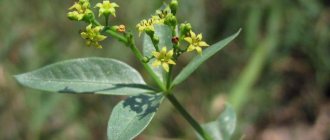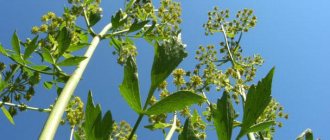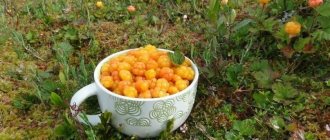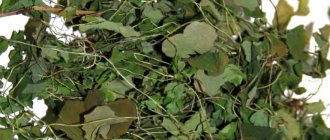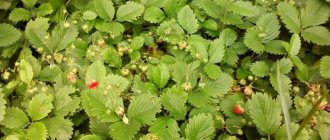Photo wp.com
There are more than three hundred types of cinquefoil, but the erect and white cinquefoil stand out for their healing properties.
I have great respect for galangal, the upright cinquefoil, and have known this plant since childhood. In our grandmother’s village, we rolled the root of galangal in our mouth almost every day. For some reason we liked its viscosity and bitter taste. A saucer with dry roots always stood on the table, and you could take them in any quantity. When we went for a walk, my sister and I filled our pockets with roots, although one piece was enough for us for several days. Grandmother scolded us for such greed, but tried not to discourage our addiction to galangal - this root was considered too useful. Much later, I tried my grandmother’s tincture of galangal root. Grandmother prepared it constantly, but only for medicinal purposes. Kalgan tincture has the same medicinal properties as the dry root, but the tincture can be used for rubbing for pain in the joints and muscles.
What are the benefits of galangal?
The whole plant is used for medicinal purposes, but most often the rhizome.
Cinquefoil has bactericidal, astringent and hemostatic properties, as it reduces capillary permeability and constricts blood vessels. Flavonoids contained in bloodroot have a powerful anti-inflammatory effect. The local medicinal effect is due to the action of tannins that can create a biological film that protects tissues from chemical, bacterial and mechanical influences that accompany inflammation.
Cinquefoil perfectly normalizes impaired immunity, improves metabolism, lowers cholesterol levels in the blood and stimulates the thyroid gland.
Relieves inflammation in colitis, hemorrhoids, dysentery, gastritis, stomach ulcers. Helps with gout, bronchitis, tuberculosis, arthritis, stomatitis and even cirrhosis of the liver.
Due to its hemostatic properties, cinquefoil is used to treat uterine bleeding due to hormonal imbalance. Many men have heard about galangal tincture. It’s not for nothing that galangal is often called the male root. The tincture improves blood circulation and increases potency. In addition, it has a beneficial effect on the nervous system and helps relieve tension in stressful situations that negatively affect male potency. It is also useful to drink for prostatitis.
My grandmother often called the roots of galangal silver and said that they contained silver. For a long time I thought she was joking, but later I found out that this element was actually present in the roots. Apparently, this explains the ability of galangal to purify water. During the haymaking, a handful of dry galangal roots were poured into a barrel of river water to disinfect it. They drank the water without boiling it, and it never went cold.
How to care for Potentilla erecta
The crop needs watering, fertilizing, loosening the soil, and removing weeds around it. To maintain a decorative appearance, faded buds are removed.
Watering
Cinquefoil Goldfinger - description, planting and care
Potentilla galangal does not need abundant irrigation. Water the plants only during drought. If sufficient rainfall occurs during the season, no additional irrigation is required. To preserve moisture in the soil, the tree trunk circle is mulched.
Top dressing
The application of fertilizers promotes the development of plants and helps them resist various diseases and pests. Shrubby galangal is fed several times a season: at the beginning of spring, before flowering, at the beginning of autumn. They use minerals intended for fertilizing decorative flowering plants.
Important! Before applying fertilizing, the root system is watered with plain water.
Trimming
Sanitary pruning is carried out throughout the season. At the same time, dry, broken, diseased branches are removed. In autumn, the above-ground part is cut off.
Where does it grow
Potentilla erecta is common in the European part of Russia.
It grows in meadows, pastures, forest clearings, forest edges, clearings, along the outskirts of peat bogs, and in sparse forests. Doctors recommend different harvesting times. My grandmother harvested cinquefoil roots at the end of August. She washed, dried and put them in canvas bags.
Popularly, the plant is better known as galangal, elm grass, ovary root, oak root, oak root, diarrhea grass, and uzik. All names, one way or another, are associated with its astringent effect.
At all times, Potentilla erecta has been popular in Rus'. It was highly valued for its ability to cure dysentery, which our ancestors often encountered.
Potentilla erecta is included in the modern pharmacopoeias of almost all European countries. Potentilla was first introduced into the Russian pharmacopoeia in 1946, but its healing properties were well known to Russian doctors in the 19th century.
Roots of galangal (cinquefoil erect). Photo pixabay.com
Procurement of raw materials
Procurement of raw materials can be carried out in spring (March - May) and autumn (August - September). The roots can be dug up with a shovel; be sure to clear them of above-ground shoots and adventitious roots.
The root, cleared of soil, should be washed with cold water. You can dry the roots outdoors, in dryers or ovens. Dried rhizomes can be stored for up to 6 years in a dark and dry place.
Medicinal plants. Large illustrated encyclopedia This book is unique.
- This is also a guide to plants, both wild and cultivated, that can be used for medicinal purposes, as it contains their visual photographs and full characteristics.
- And a herbalist - thanks to a variety of recipes used for the most common diseases, with precise dosages and a detailed description of the preparation process.
- And a guide to collecting and preparing medicinal herbs.
- And even a guide to growing and caring for cultivated medicinal plants.
The author of this encyclopedia is T.A. Ilyina, a candidate of biological sciences, summarized her own experience and professional knowledge. Buy the electronic version Buy the paper version
Stomatitis
One teaspoon of crushed cinquefoil roots is poured into one glass of warm water and left overnight.
In the morning, bring to a boil, allow to cool and filter. Rinse your mouth with warm broth several times a day until the condition improves. Inflammation of the appendages Mix dry crushed cinquefoil roots, calendula flowers and birch buds in equal proportions. Two tablespoons of the collection are poured with one liter of boiling water and simmered over low heat for ten minutes. The broth is poured into a thermos, left overnight, filtered and boiling water is added to the original volume of liquid. Take half a glass of decoction three to four times a day. The course of treatment is from one to three months.
The same decoction helped a friend of mine restore tubal patency and cure infertility.
How to use
Decoctions, infusions and tinctures are made from cinquefoil. Decoctions, tinctures and ointments are made from cinquefoil. The dosage of ingredients depends on the method of use. If the medicine from Potentilla erecta is used externally, the solution should be 2-3 times more concentrated than for internal use.
Decoction for cirrhosis
With the help of the rhizome of Potentilla erecta, you can slow down and completely stop the process of liver destruction in cirrhosis. Treatment will be effective only with an integrated approach - combination with drug therapy, diet, active lifestyle, lack of alcohol and proper rest. While taking the decoction, consume no more than 4 g of salt and up to 600 ml of liquid during the day.
Ingredients:
- Potentilla erecta root (powder) - 5 g.
- Potentilla erecta grass - 25 g.
- Water (boiling water) - 600 ml.
How to prepare : Mix the roots with the herb, pour boiling water and place in a water bath for 30 minutes. Remove the broth from the stove, leave for 30 minutes and strain.
How to use : Take the decoction warm 3 times a day, 50-100 ml, 2 hours before meals. The course of treatment is 30 days. It is held 2 times during the year.
Result : A decoction of Potentilla erecta weakens the signs of chronic infection, accelerates the flow of bile and prevents the development of congestion in the liver and gall bladder. Liver functions are gradually restored.
Infusion for rheumatism and gout
If you suffer from rheumatic and gouty pain, supplement traditional drug treatment with an infusion of cinquefoil rhizome.
Ingredients:
- Potentilla erecta roots (powder) - 1 tbsp.
- Water (boiling water) - 1.5 cups.
How to prepare : Pour boiling water over the crushed rhizomes, cover the dishes with a towel and leave the liquid for 6 hours. Strain through several layers of gauze.
How to use : Drink the infusion 3 times a day, ¼ cup.
Result : Cinquefoil infusion effectively eliminates acute pain, removes salt deposits from joints, strengthens blood vessels and relieves inflammation.
Infusion for dysentery
In folk medicine, galangal infusion is the most popular remedy for dysentery. Drink plenty of fluids, including water and tea, while taking the medicine.
Ingredients:
- Potentilla erecta roots (powder) - 1 tbsp.
- Water (boiling water) - ¼ cup.
How to prepare : Pour the rhizome powder into a thermos, pour boiling water, close the lid tightly and keep for 3 hours. Then strain through cheesecloth or a sieve.
How to use : Drink 1 tbsp 3 times a day.
Result : Thanks to its strong antibacterial effect, the infusion quickly stops diarrhea, vomiting and nausea, relieves fever, removes toxins from the gastrointestinal tract, relieves pain in the lower abdomen and restores appetite.
Tincture for bleeding
An alcohol tincture of Potentilla erecta is used as an antiseptic and, due to its astringent properties, prevents internal bleeding.
Ingredients:
- Potentilla erecta roots (powder) - 2 tbsp.
- Vodka - 20 tbsp.
How to prepare : Pour the crushed root into a bowl, pour in vodka, stir and place in a cool, dark room for 14 days.
How to use : Take 30 drops before meals.
Result : Galangal tincture creates a protective film at the site of bleeding, which prevents the action of the bactericidal environment on the capillaries. Thus, the medicine stops the onset of the inflammatory process, and the tissues heal completely.
Ointment for burns and ulcers
Potentilla ointment is an excellent remedy for ulcers, frostbite, burns, weeping eczema and other skin diseases.
Ingredients:
- Potentilla erecta root (powder) - 1 tbsp.
- Butter - 5 tbsp.
How to prepare : Soften the butter in a water bath and mix with the cinquefoil.
How to use : Apply ointment to the affected area for 2-3 hours.
Result : Cinquefoil erecta root has hemostatic, analgesic, astringent, antimicrobial and anti-inflammatory effects and heals ulcers and burns without the formation of scars.
Decoction for seizures and tetanus
If you are experiencing leg, arm and body cramps, including muscle spasms due to tetanus, try a milk and galangal infusion.
Ingredients:
- Potentilla erecta roots (powder) - ½ tsp.
- Potentilla erecta herb - ½ tsp.
- Milk - 1 glass.
How to prepare : Heat the milk, but do not boil. Pour the chopped roots and grass over it and leave for 30 minutes.
How to use : Take the decoction before meals 3 times a day, ¼ cup.
Result : A milk decoction of galangal roots and herbs relieves nagging muscle pain and numbness during cramps, making attacks less frequent and weaker.
Tincture for stomach disorders
Tincture of galangal with vodka has a beneficial effect on the entire gastrointestinal tract and accelerates its recovery in various disorders.
Ingredients:
- Potentilla erecta roots (powder) - 1 tbsp.
- Vodka - 1 glass.
How to prepare : Pour vodka over the galangal and leave in a warm room for 2 weeks. Strain the tincture through gauze folded in 2-3 layers.
How to use : Drink 50 drops 3 times a day.
Result : Kalgan rhizomes regenerate the mucous membranes of the gastrointestinal tract, normalize the functions of the secretory glands, suppress inflammatory processes, improve digestion and normalize the intestinal flora. Using vodka tincture of bloodroot, you can quickly relieve colic, eliminate vomiting, nausea and heartburn.
Decoction for stomatitis
Rinsing with a decoction of galangal helps with stomatitis, gingivitis, periodontal disease, loosening of the gums and bad breath.
Ingredients:
- Potentilla erecta root (powder) - 1 tsp.
- Water - 1 glass.
How to prepare : Pour water over the roots, stir and leave for 5 hours. Then pour into an enamel pan and boil for 2-3 minutes. Cool the broth.
How to use : Rinse your mouth with the broth several times a day.
Result : A decoction of Potentilla erecta stops the inflammatory process, relieves pain, destroys bacteria and microbes and heals wounds on the oral mucosa.
Decoction for diarrhea
A decoction of galangal grass and roots works well for loose stools.
Ingredients:
- Potentilla erecta roots (powder) - ½ tbsp.
- Potentilla erecta herb - ½ tbsp.
- Water - 2.5 glasses.
How to cook : Pour the grass and roots into an enamel pan, add water and place on low heat. Bring to a boil and cook for 15 minutes, then remove from heat and leave for 60 minutes. Strain the liquid through a sieve or cheesecloth.
How to use : Drink the decoction 3 times a day, ½ cup, 20 minutes before meals or 60 minutes after meals.
Result : The antiseptic, anti-inflammatory and astringent properties of bloodroot help stop diarrhea and eliminate painful bloating.
Tincture for potency
Cognac tincture of galangal effectively restores potency in men and is used to prevent various sexual disorders. If you don't have cognac, replace it with 70% medical alcohol or vodka.
Ingredients:
- Potentilla erecta roots - 100 g.
- Cognac - 500 ml.
How to prepare : Pour cognac over the dry roots and leave for 7 days.
How to use : Use 2 times a day, 1 tbsp. 20 minutes before meals.
Result : Galangal roots improve blood circulation, relax smooth muscles, eliminate insomnia and stress and increase male potency.
For more information about Potentilla erecta, watch the video:
Appearance of the plant
Cinquefoil erecta, or galangal grass, belongs to the Rosaceae family. The thin stem rises above the ground to a height of 15-50 centimeters. In the root zone, the leaf blades are divided into 3 or 5 parts and have a petiole attached to the stem. The leaves on the stem are trifoliate and sessile. The rhizome is powerful, cylindrical in shape.
Yellow flowers are located at the top. The diameter of the corolla is within 2 centimeters. By the number of petals (4) in the corolla they are distinguished from other types of cinquefoils. The fruit is a nut in which from 5 to 12 seeds ripen. Flowering period is May-August. The seeds ripen in August-September.






